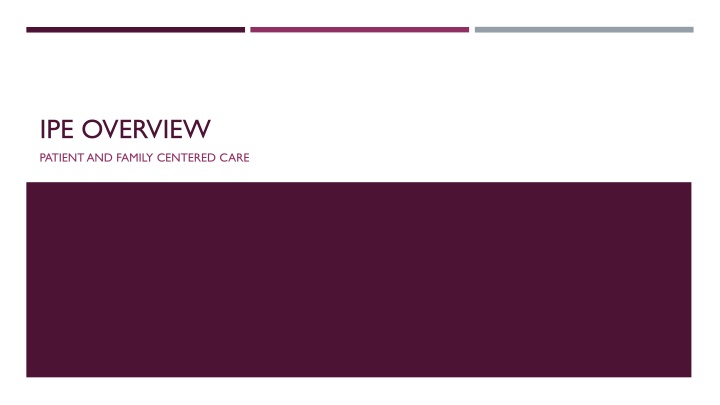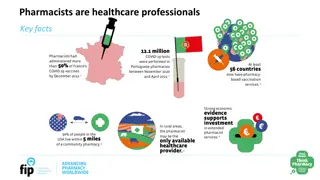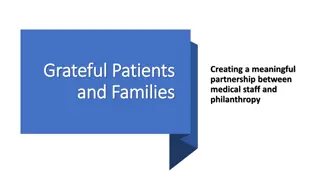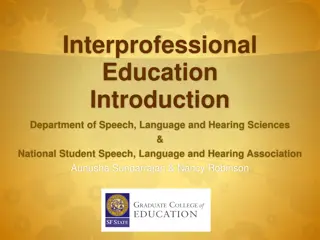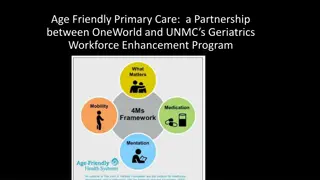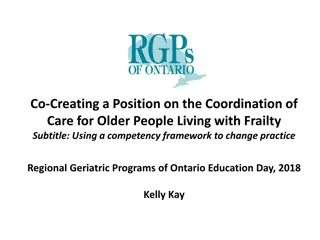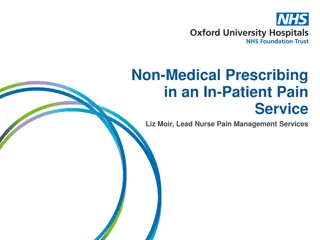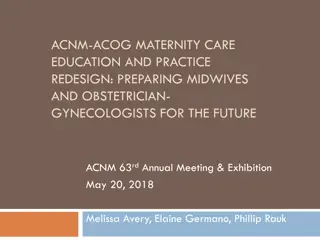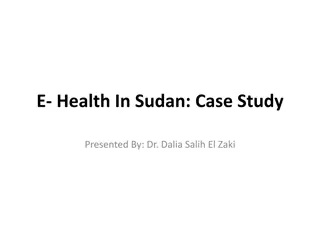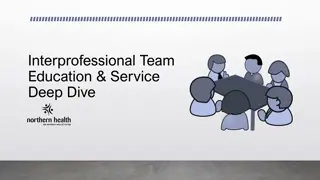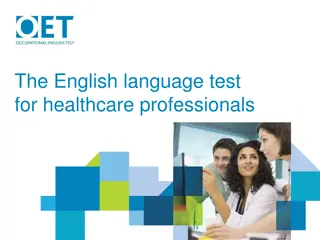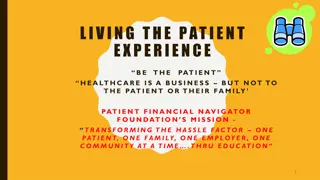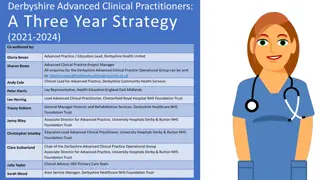Transforming Healthcare Through Interprofessional Education
Glaring gaps and inequities in health persist globally, calling for a transformation in professional health education. Interprofessional Education (IPE) fosters collaborative practice among students from various health and social care professions to enhance patient-centered care. The Lancet emphasizes the need to strengthen health systems through redesigned education to address emerging health challenges. By focusing on the Triple Aim of Health Care, IPE aims to improve patient experience, enhance population health, and reduce healthcare costs.
Download Presentation

Please find below an Image/Link to download the presentation.
The content on the website is provided AS IS for your information and personal use only. It may not be sold, licensed, or shared on other websites without obtaining consent from the author.If you encounter any issues during the download, it is possible that the publisher has removed the file from their server.
You are allowed to download the files provided on this website for personal or commercial use, subject to the condition that they are used lawfully. All files are the property of their respective owners.
The content on the website is provided AS IS for your information and personal use only. It may not be sold, licensed, or shared on other websites without obtaining consent from the author.
E N D
Presentation Transcript
IPE OVERVIEW PATIENT AND FAMILY CENTERED CARE
PATIENT AND FAMILY CENTERED CARE https://www.youtube.com/watch?v=cDDWvj_q-o8
THE LANCET HEALTH PROFESSIONALS FOR A NEW CENTURY: TRANSFORMING EDUCATION TO STRENGTHEN HEALTH SYSTEMS IN AN INTERDEPENDENT WORLD Glaring gaps and inequities in health persists both within and between countries Fresh health challenges loom New infections, environmental and behavioral risks at a time of rapid demographic and epidemiological transitions, threaten health security of all Frenk, J., et al. (2010). Health professionals for a new century: Transforming education to strengthen health systems in an interdependent world. The Lancet.; 376; 1923-58.
THE LANCET HEALTH PROFESSIONALS FOR A NEW CENTURY: TRANSFORMING EDUCATION TO STRENGTHEN HEALTH SYSTEMS IN AN INTERDEPENDENT Professional education has not kept pace with these challenges Redesign of professional health education is necessary and timely Opportunities for mutual learning and joint solutions Frenk, J., et al. (2010). Health professionals for a new century: Transforming education to strengthen health systems in an interdependent world. The Lancet.; 376; 1923-58.
INTERPROFESSIONAL EDUCATION : A REVIEW OF CONTEXT, LEARNING AND THE RESEARCH AGENDA Conclusion: Growing interest in IPE and in its education and research agenda to develop best practice models based on evidence of effectiveness Requires educators and practicing health care professionals to collaborate to provide authentic learning experiences for students who are preparing to work together Thistelthwaite, J. (2012). Interprofessional education: A review of context, learning and the research agenda. Medical Education; 46:58-70.
WHAT IS IPE When students from two or more professions in health and social care learn together during all or part of their professional education with the object of cultivating collaborative practice for providing client-or patient centered health care Vision: Transforming healthcare through interprofessional education and collaborative practice Triple Aim of Health Care (1) Improve the patient s experience of care (2) Improve the health of populations (3) Decrease the cost of care https://www.google.com/search?q=what+is+interprofessional+education&client=firefox-
TRIPLE AIM Improve the patient experience of care Improve the health of populations Reduce the per capita cost of health care
QUADRUPLE AIM https://www.google.com/search?q=what+is+interprofessional+education&client=firefox-
QUADRUPLE AIM https://www.google.com/search?q=what+is+interprofessional+education&client=firefox-
HOW WE MEASURE UP National Scorecard on U.S. Health System Performance provided by the Commonwealth Fund Commission on a High Performance Health System Scorecard measures health system across 42 Key Indicators of health care quality, access, efficiency, equity, and healthy lives. In particular, the report notes significant erosion in access to care and affordability of care, as health care costs have risen far faster than family incomes. The Commonwealth Fund; https://www.commonwealthfund.org/publications/newsletter-article/new-national- scorecard-health-system-performance-us-gets-only-64
WHY IPE U.S health care system overall score of 66% (2006) Expenditures are far higher than those of other developed countries, results are no better Spending nearly double than that of the next most costly nation U.S ranks: 31st among nations on life expectancy 36th on infant mortality 28th on male healthy life-expectancy 29th on female healthy life expectancy Berwick, Nolan, & Whittington (2008) The Triple Aim: Care. Health, and Cost
WHY IPE https://www.google.com/search?q=what+is+interprofessional+education&client=firefox
IPE GOALS To improve knowledge, skills, and attitudes necessary for graduates to contribute toward improving the patient care experience, improving the health of the population, and decreasing the cost of care through a longitudinal interprofessional education and collaborative practice curricular model. To create a patient and family centered collaborative practice workforce prepared to impact health related outcomes. To create and dynamically adapt the content of the triple aim curriculum to focus upon and address the local and regional social determinants of health impacting the State of Arkansas. To participate in a triple aim curriculum graduation expectation that contributes directly toward the institutional mission within the realms of education, clinical practice, and research. To meet and exceed compliance with relevant professional and accreditation standards.
IPE GENERAL COMPETENCIES Values/Ethics Work with individuals of other professions to maintain a climate of mutual respect and shared values. Roles and Responsibilities Use the knowledge of one s own role and those of other professions to appropriately assess and address the healthcare needs of the patients and populations served. Communication Communicate with patients, families, communities, and other health professionals in a responsive and responsible manner that supports a team approach to the maintenance of health and the treatment of disease. Teams and Teamwork Apply relationship-building values and the principles of team dynamics to perform effectively in different team roles to plan and deliver patient-/population-centered care that is safe, timely, efficient, effective, and equitable.
IPE BEGINNINGS 2009 six national associations of schools of health professions formed a collaborative to promote and encourage constituent efforts that would advance substantive interprofessional learning experiences.
PROFESSIONS REPRESENTED IN 2009 Dentistry, Nursing, Medicine, Osteopathic Medicine, Pharmacy, and Public Health
9 NEW MEMBERS IN 2016 American Association of Colleges of Podiatric Medicine; American Council of Academic Physical Therapy; American Occupational Therapy Association; American Psychological Association; Association of American Veterinary Medical Colleges; Association of Schools and Colleges of Optometry; Association of Schools of Allied Health Professions; Council on Social Work Education; and Physician Assistant Education Association
GOALS OF IPE Prepare future health professionals for enhanced team-based care of patients Improve Population Outcomes
WHY WE NEED COLLABORATION Developing leaders in interprofessional education who have The knowledge, skills and attitudes to teach both learners and fellow colleagues the art and science of working collaboratively for care. https://www.google.com/search?q=what+is+interprofessional+education&client=firefox
COCA REQUIREMENT 6.8 Interprofessional Education for Collaborative Practice COM faculty must ensure that the core curriculum prepares osteopathic medical students to function collaboratively on health care teams, adhering to the IPEC core competencies, by providing opportunities, in each year of the curriculum, to learn in academic and clinical environments that permit interaction with students enrolled in other health professions degree programs. Commission on Osteopathic Accreditation (July 2019)
CODA DENTAL HYGIENE STANDARDS 2-15 Graduates must be competent in communicating and collaborating with other members of the health care team to support comprehensive patient care. Intent: The ability to communicate verbally and in written form is basic to the safe and effective provision of oral health services for diverse populations. Dental Hygienists should recognize the cultural influences impacting the delivery of health services to individuals and communities (i.e. health status, health services and health beliefs). Students should understand the roles of members of the health-care team and have educational experiences that involve working with other health-care professional students and practitioners. Examples of evidence to demonstrate compliance may include: student experiences demonstrating the ability to communicate and collaborate effectively with a variety of individuals, groups and health care providers. examples of individual and community-based oral health projects implemented by students during the previous academic year evaluation mechanisms designed to assess knowledge and performance of interdisciplinary communication and collaboration CODA Accreditation Standards for Dental Hygiene Education (2018)
ADEA CORE COMPETENCIES Health Care Policy, Interprofessional Collaboration, and Advocacy refers to the understanding of policy and its development, the value of collegiality and interprofessional collaboration, and advocacy related to the promotion of health, education, and the profession of dental hygiene. Journal of Dental Education (2012) Volume 76, 7
CNEA STANDARD II CULTURE OF INTEGRITY AND ACCOUNTABILITY The nursing program seeks and utilizes feedback from communities of interest to inform program development and decision-making about the educational preparation of students. Partnerships among communities of interest and the nursing program promote a sense of cohesiveness and intra- and interprofessional collaboration, leading to contemporary experiential learning experiences for students with a goal of preparing a diverse, competent workforce NLN Commission for Nursing Education Accreditation (2016)
HOW DO WE HEAL MEDICINE Our medical systems are broken. Doctors are capable of extraordinary (and expensive) treatments, but they are losing their core focus: actually treating people. Doctor and writer Atul Gawande suggests we take a step back and look at new ways to do medicine with fewer cowboys and more pit crews. Atul Gawande TED2012 ttps://www.ted.com/talks/atul_gawande_how_do_we_heal_medicine?language=en
RESOURCES https://www.youtube.com/watch?v=cDDWvj_q-o8 Frenk, J., et al. ()2010). Health professionals for a new century: Transforming education to strengthen health systems in an interdependent world. The Lancet.; 376; 1923-58. Thistelthwaite, J. (2012). Interprofessional education: A review of context, learning and the research agenda. Medical Education; 46:58-70. Berwick, D.M. et al. (2008) Health Aff: 27; 759-769 Bodenheimer, T. & Sinsky, C. (2014) Annals of Family Medicine: 12;573-576. The Commonwealth Fund; https://www.commonwealthfund.org/publications/newsletter- article/new-national-scorecard-health-system-performance-us-gets-only-64 Berwick, Nolan, & Whittington (2008) The Triple Aim: Care. Health, and Cost
RESOURCES Commission on Osteopathic Accreditation (July 2019) CODA Accreditation Standards for Dental Hygiene Education (2018) Journal of Dental Education (2012) Volume 76, 7 NLN Commission for Nursing Education Accreditation (2016) ttps://www.ted.com/talks/atul_gawande_how_do_we_heal_medicine?language=en
